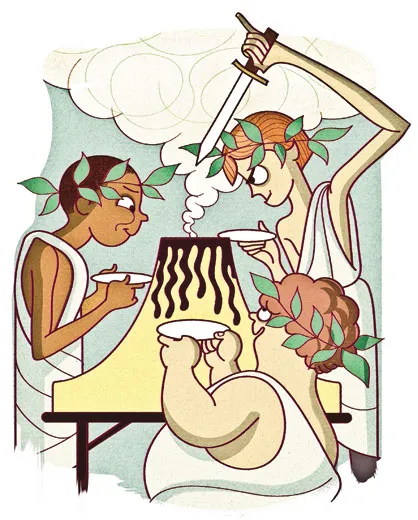Ad Nauseam
Recreating a Roman banquet seemed like a good idea
/https://tf-cmsv2-smithsonianmag-media.s3.amazonaws.com/filer/Last-Page-Roman-banquet-631.jpg)
In a fit of nostalgia for the 2,034th-birthday party my high-school Latin class threw for Virgil, I signed on as chairperson for the Authentic Roman Banquet at my 12-year-old son’s middle school. My son hates Latin (which I made him take), and I was hoping the banquet would bring the language alive for him and his equally alienated classmates. I had forgotten nullum beneficium est impunitum: no good deed goes unpunished.
A little research turned up the disheartening news that everything culinary we associate with Rome today—pasta, pizza, etc.—came long after Julius Caesar. A cookbook of ancient recipes didn’t help. Many Roman dishes were garnished with a sauce called garum: place 20 mackerel in a vat with brine and leave in the sun until liquefied. Nowadays, you can mix anchovy paste and Worcestershire sauce to mimic the taste—but who would want to? Fortunately, one of the other moms on the committee came up with a garum-less recipe: ham with honey and figs wrapped in pastry. Roman pigs-in-a-blanket.
The ancient Romans would have served wine, of course. There were a number of reasons we could not, including state law. We opted for grape juice in goblets.
Next came the question of the auspicia (auspices). If the gods were willing to let the banquet go forward, they would send favorable signs and the guests could be seated. This traditionally involved the release of live birds or examining the entrails of a sacrificial animal. We opted for the birds—until we realized that the board of health would likely frown on airborne creatures in an indoor dining area.
Finally, a reasonable facsimile of a Roman banquet got underway. I had pictured the kids reclining on pillows at low tables, exchanging conversational pleasantries: Canis meus id comedit (“My dog ate it”), Atque memento, nulli adsunt Romanorum qui locutionem tuam corrigant (“And remember, there aren’t any Romans around to correct your pronunciation”). Instead, they donned their togas and laurelish wreaths with the dread they usually reserve for jackets and ties. They loosened up when we started a round of Pin the Dagger on Julius Caesar, however, and by the time dessert was served we could have convened a forum for discussion of the California seedless grape as a projectile.
For dessert there was an enormous ice-cream Mount Vesuvius, complete with a crater for eruptions of dry ice and trails of gooey hot-fudge lava running down the sides. It took five students just to carry it in, and it was clearly the hit of the evening.
Later, looking at what was left of the miniature Vesuvius—a few slivers of dry ice—I realized that even if we hadn’t been able to duplicate a Roman banquet exactly, we had at least captured its essence: wretched excess. And, oh yes, my son still failed Latin.
Philomène Offen is a freelance writer and local historian who lives in La Jolla, California.
